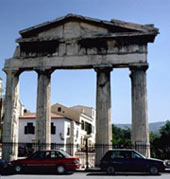
The Greek Parliament (Old Palace)
A representative sample of the early period of neoclassicism in Greece, the building is an abstemious work of strict geometry in its mass. It was built between 1836 and 1840 and originally served as a palace of Otto, the first King of Greece after the end of the Turkish occupation. In 1884 and 1909 the building suffered damages in fire and in 1910 was abandoned by the royal family. It was then remodeled to house the Hellenic Parliament in 1930. Today it serves still as the seat of the Hellenic Parliamnet and houses offices, the National Assembly Room, the office of the president of the Assembly, the Archives and other services.
The National and Kapodistrian University of Athens
The University of Athens forms part of the so-called "Neoclassical trilogy" of the city of Athens: Academy-University-Library. It consists of a group of built masses that shape up a double "T", with two symmetrical courtyards. The building follows the basic aesthetic rules of early neoclassicism, while at the same time is adapted to the Greek Mediterranean climate. It was built between 1839 and 1864 and today serves as headquarters of the University of Athens.
Location: 30 Panepistimiou Street

The Academy of Athens
The Academy of Athens, the second of building of the Trilogy, consists of aesthetically distinct parts that form a harmonic ensemble of built masses. It was built in two phases , in 1859-1863 and 1868-1885.
Location: 28 Panepistimiou Street
The National Library
The third building of the Trilogy was constructed between 1887 and 1902, and houses the most complete Public Library of Greece.
Location: 32 Panepistimiou Street
The Old Parliament Building
The Old Parliament Building is located in the square where the statue of Theodoros Kolokotronis, commander-in-chief of the 1821 Revolution, is also situated. The duilding is an architectural jewel in the centre of Athens and one of the most historic buildings of the city. It was there that the First Hellenic Democracy was proclaimed in 1924. After the transfer of the Parliament to the Old Palace (today’s Parliament Building), it was assigned to house the National Historical Museum.
Location: Stadiou & Kolokotroni Street


Olympeion (Stiles Olympiou Dios)
In 515 BC, Peisistratos the Younger, began the construction of a monumental temple in the honor of Zeus, which originally had 104 columns, but was never finished because of th fall of the tyranny in Athens. Much later, in 174 BC, Antiochos IV Epiphanes, the king of Syria, attempted to continue the erection of the temple which was finally completed by the Roman emperor Hadrian, in AD 124/125. Inside the temple stood a colossal chryselephantine (gold and ivory) statue of Zeus. Many parts of the circuit wall of the sanctuary have been rebuilt, initiating the ancient masonry. Sections of the ancient wall have been preserved only at the south-east corner and on the north side.
Location: Vasilissis Olgas Ave. - The site is open daily 8.30 am - 3.30 pm
Hadrian's Arch
The triumphal arch lies on an ancient street that led from the old city of Athens to the new, Roman section, built by Hadrian. It was constructed by the Athenians in AD 131 in honor of their benefactor emperor. Two inscriptions are carved on the architrave, one on each side: the first, on the side towards the Acropolis reads "This is Athens, the ancient city of Theseus": the second, on the other side, facing the new city reads "This is the city of Hadrian and not of Theseus".
